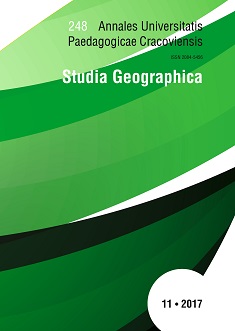The Polish nobility contribution in developing the potential cultural landscapes on Bessarabia territory
Słowa kluczowe:
noble house, historical and cultural heritage, cultural landscape, dendrological parksAbstrakt
Cultural landscapes, created in time under the influence of natural and anthropic factors, were subject to quantitative and qualitative changes. In the structure of landscapes, you can also notice degradation, ruin, abandonment etc. This presentation of the research results is aimed at counteracting the decline of this cultural phenomenon in the Republic of Moldova and finding real solutions based on the description, analysis, interpretation of noble parks, in historical Bessarabia which were created by the activities of the nobility of Polish origin. Monuments of landscape architecture in the Republic of Moldova are estimated based on the typology carried out by Cocean Pompeia. According to representative genetic cronies, as well as the definition of cultural landscapes, we chose cultural landscapes resulting from production activities: parks with noblemen’s manors. The Polish nobility in the historical Bessarabia had an important role in the process of cultivating the landscapes. She left a specific architecture behind her - dehydro-parks designed by well-thought-out structures. Manor houses and deontrological parks in the territory of the Republic of Moldova, those who were created thanks to the activities of the nobility of Polish origin are recorded in the Register of monuments under the protection of the state. Today, these monuments are in very bad condition, and the institutions of the Moldovan state are unable to find a solution to this problem and lack of money. However, despite this, today noble houses and deontrological parks are very important elements of landscape pictures, and can become a good element in the development of tourism in Moldova.Bibliografia
Baciu, V. (2010). Conacele boiereşti din Basarabia (Volumul I). Timpul, Cotidian Naţional Independent.
Cocean, P., David, N. (2014). Peisaje culturale. Cluj-Napoca: Editura RISOPRINT.
Cocîrţă, P. (2011). Patrimoniul natural şi socio-cultural. Starea mediului în Republica Moldova, în 2007–2010 (Raport Naţional), Chişinău.
Filipescu, C., Giurgea, E. (1919). Basarabia-consideraţii generale, agricole, economice şi statistice. Chişinău: Institutul de arte grafice „România nouă”.
http://cuvintul.md/article/Conacul-Andrianov-o-piesa-istorica-pe-harta-satului-Raspopeni/
http://www.moldovenii.md/md/section/331/content/4096
https://observatorul.md/turism/2017/01/14/22263_intre-nistru-si-prut-conacul-bjozowskz-din-solonet
https://www.facebook.com/pg/AIRM.Moldova/photos/?tab=album&album_id=369090189782407
Kuleshova, M. (2011). Cultural landscape in the World Heritage List. Regional Seminar for CIG Countries “Safeguarding World Heritage in the context of New Global Challenges”, Moskow.
Law no.1530-XII of 22.06.93 regarding protection of monuments of the Republic of Moldova. Monitorul Oficial No.1/3 on 30.01.1994.
Law no.1538 of 25.02.1998 regarding the fund of state protected natural areas. Monitorul Oficial No. 66–68 art. No: 442 on 16.07.1998.
Леонтьев, П.В. (1967). Парки Молдавии. Кишинёв: Картя Молдовеняскэ.
Register of state protected monuments of the Republic of Moldova. Approved by the Parliament Decision no. 1531-XII of 22.06.1993.
Stoica, F., Schreiber, W. (2008). Peisaje culturale istorice. Cluj-Napoca: Editura “Argonaut,,.
Tarhon, P. (2013). Parcurile vechi boiereşti din Republica Moldova. AŞM, Muzeul Naţional de Etnografie şi Istorie Naturală. Chişinău: Editura „Pontos”.
Opublikowane
Numer
Dział
Licencja
Złożenie artykułu do druku oznacza wyrażenie zgody na bezpłatne (tj. bez honorariów autorskich) przeniesienie autorskich praw majątkowych na Wydawcę i zezwolenie na wydanie pracy w postaci drukowanej w dowolnej liczbie egzemplarzy oraz zamieszczenie jej w postaci otwartego dostępu na stronie internetowej czasopisma, w bibliotekach cyfrowych oraz innych cyfrowych platformach wydawniczych, z którymi Wydawca zawarł lub zawrze stosowne porozumienie o udostępnianiu. W przypadku artykułów wieloautorskich przyjmuje się, że autor zgłaszający pracę („correspondingauthor”) ma pełnomocnictwo do reprezentowania pozostałych współautorów w tym zakresie. Autorzy są proszeni o podpisanie stosownego oświadczenia w tej sprawie.

